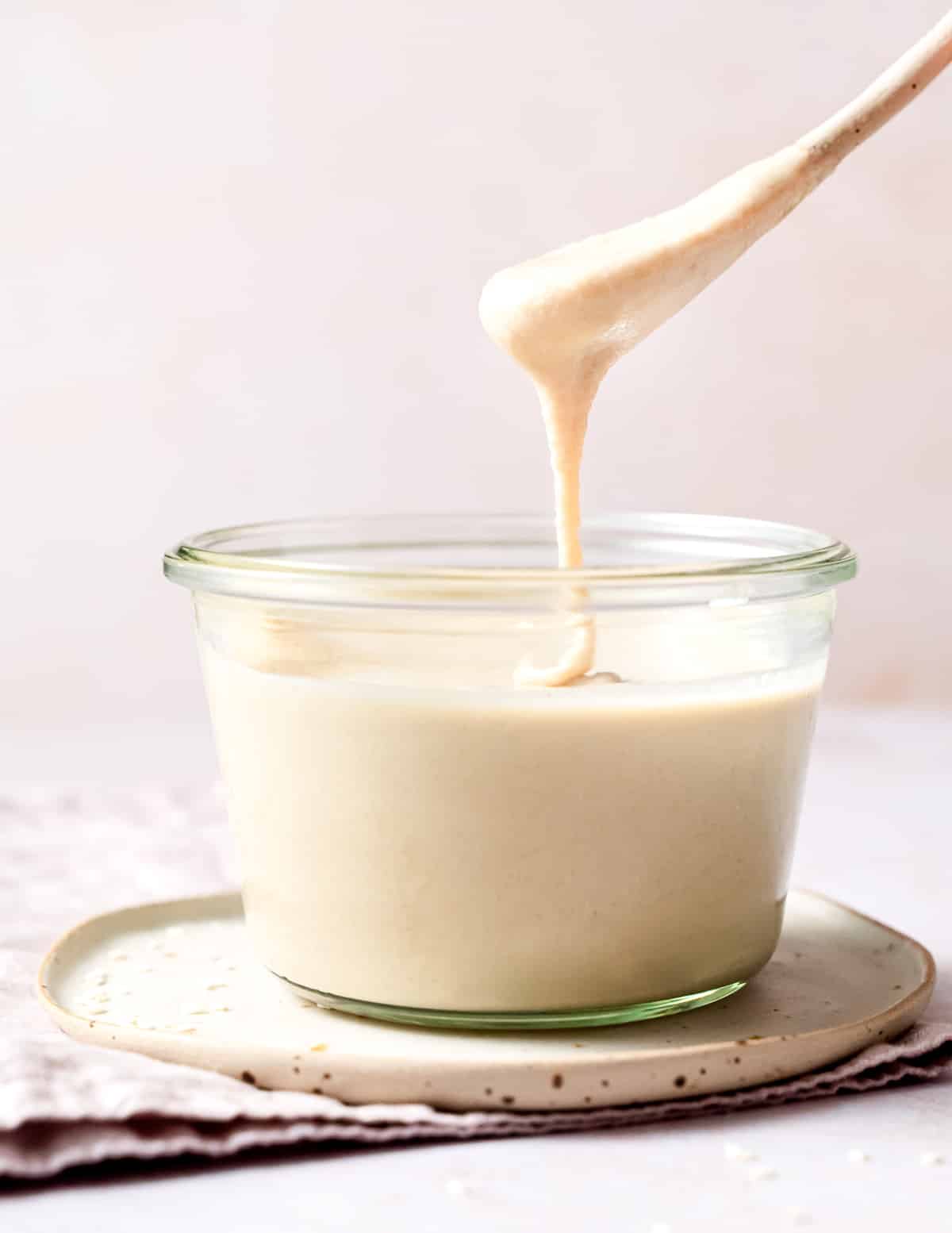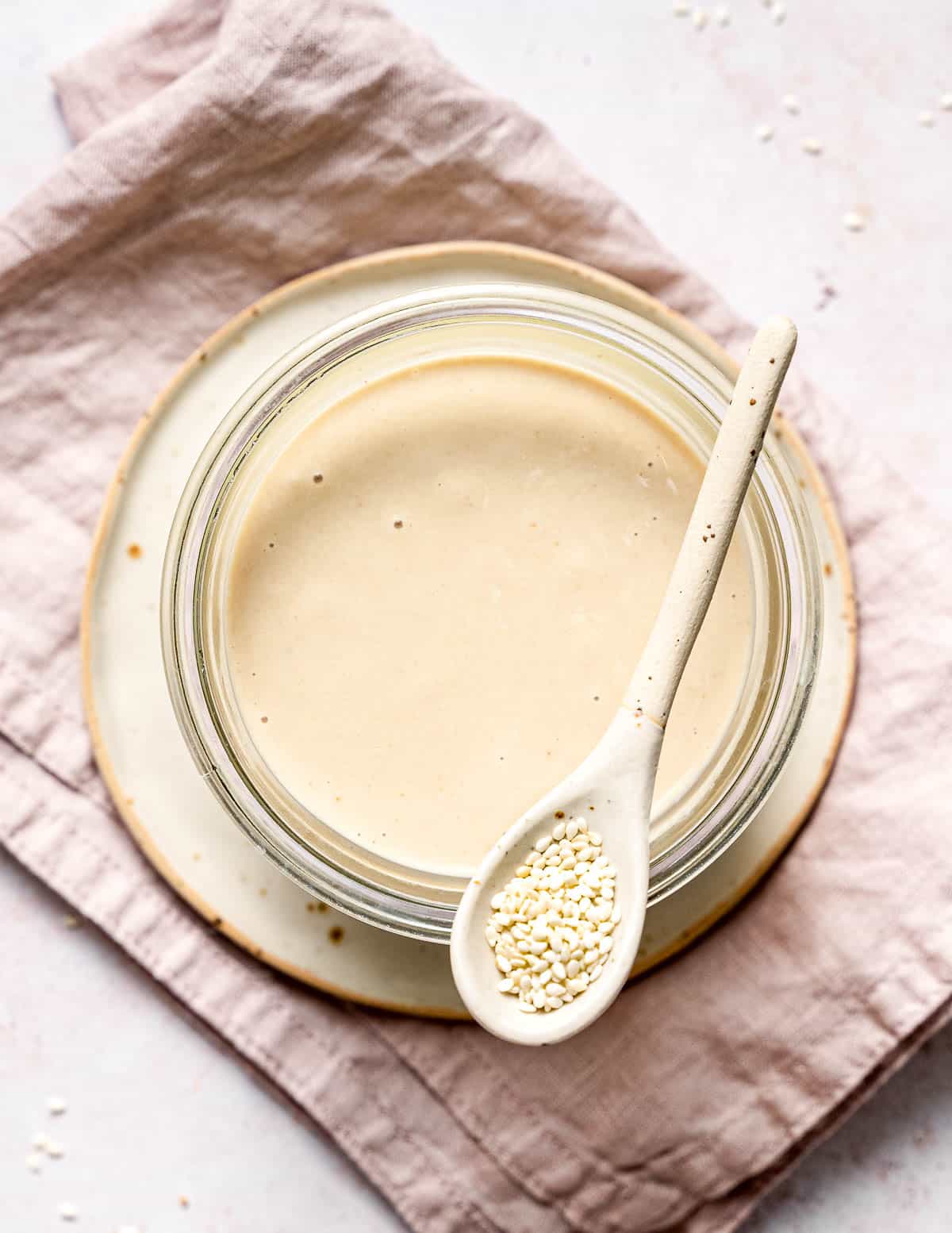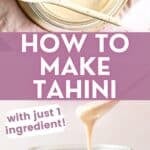Learn how to make tahini. All you need is 1 ingredient (sesame seeds), a food processor, and about 10 minutes. You will be rewarded with the most delicious, creamy, drippy, tahini!

💌 SAVE THIS RECIPE!
Watch out for more tasty treats coming your way too! Unsubscribe at any time.
Jump to:
Something magical happens when you give some sesame seeds a spin in a food processor. In just a few minutes you'll have a perfectly creamy, drippy tahini with sesame-intense flavour. It's the definition of simplicity and so delicious!
Tahini is a pantry staple here at AVV HQ and the homemade version is so much nicer (and cheaper!) than most store-bought tahini. It's great for use in all kinds of sweet and savoury dishes. My absolute favourite way to use it is in my Chocolate Tahini Crunch Bars or my Tahini Banana Bread!
Mel x
Ingredients
Just like when making peanut butter or almond butter, all you need is one ingredient. In this case, that ingredient is sesame seeds.

You can add a pinch of salt too if you like but it's not necessary. As for the sesame seeds, you can use hulled or unhulled. The choice is yours. Hulled sesame seeds result in a paler, milder, slightly sweeter, and much smoother tahini. Unhulled sesame seeds are darker in colour and as a result will produce a darker tahini with a stronger and slightly bitter flavour.
How To Make Tahini At Home
Your homemade tahini is ready in just a few easy steps:

- First, you need to toast or dry roast the sesame seeds. You can do this in just a few minutes by spreading them out on a baking sheet and roasting them in an oven or in a dry skillet on the stovetop. They can burn quickly and easily so keep a close eye on them.

- Add the toasted sesame seeds to a food processor. It is possible to use a blender if it's a high-powered one like a Blendtec or Vitamix but even they will struggle a little to get things going without the addition of some oil. A food processor is the best option.
- Blend. First, it will look like a clumpy coarse flour.
- Then it will start to turn into a thick coarse paste. You will need to scrape the sides down a few times during blending.
- All of a sudden after blending for a good few minutes it will turn into creamy, drippy, perfectly smooth perfect tahini with a creamy, drippy, melty, perfectly smooth consistency.
Success Tip
Roasting/toasting releases the natural oils in the sesame seeds which really helps with the blending process. This means that you can make this tahini recipe without using any added oil. It also intensifies the flavour of your tahini making it much more toasty and nutty.
Storing Homemade Tahini
Store your tahini in a jar or other airtight container. If you are going to finish it quickly (within a couple of weeks), then you can store it in the pantry (or other cool area), but if not, the refrigerator or freezer is best. In the fridge, it should keep well for up to 3 months, and in the freezer for 6 months.

Stored at room temperature tahini will stay nice and drippy and drizzle-able. From the fridge, it will be thicker. Either way, you might find that the oil separates and rises to the top. Simply stir it in with a knife before using.
Freezing Tip
Use an ice cube tray then you can pop out just a cube or two as needed! They defrost super-quickly.
How To Use Homemade Tahini
Tahini is naturally gluten-free and really versatile. It can be used in both sweet and savoury dishes. It's a really popular ingredient in Middle Eastern and Mediterranean dishes. I love it:
- Drizzled on oatmeal
- In smoothies to add healthy fats and protein
- Spread on toast (great with sliced bananas)
- Added to salad dressings and dips like homemade hummus and baba ganoush
- Made into savoury tahini sauce to serve with bowl meals, vegetables, falafel, pita bread etc
- In baked goods like cookies and banana bread
Some of my favourite recipes that use tahini here on A Virtual Vegan are:
Tahini Recipe FAQs
Tahini has a nutty, toasty, sesame flavour and is slightly bitter. Tahini made with roasted sesame seeds tends to taste a little milder than tahini made from unhulled or raw seeds.
Every food processor/blender's strength is a little different. Some will take less time and some will take more time. It sounds like your tahini probably just needed an extra few minutes in the food processor. It should get there, you just need to be patient and keep going! There is always a chance though that your food processor just isn't powerful enough for the job at hand. Adding a tablespoon or two of good-quality olive oil will help loosen things up and make it easier on your food processor to get the consistency you need.
Yes, you can but its flavour is stronger and more bitter than tahini made with white sesame seeds.
It is possible to use a blender if it's a high-powered one like a Blendtec or Vitamix but even they will struggle a little to get things going without the addition of some oil. A food processor is the best option, especially for a recipe like this one with no added oil.
In the fridge, it should keep well for up to 3 months, and in the freezer for 6 months. Be sure to use a clean, dry spoon when scooping your tahini out of the jar to limit any contamination.
Yes, it should work just as well. You can even substitute other seeds like sunflower seeds to make sunflower seed butter, or a combination of nuts/seeds.
The coating on unhulled sesame seeds can be a little bitter. Using hulled sesame seeds will reduce the bitterness.
Yes, tahini can be used as a direct substitute for any nutter butter in recipes. It has a very similar fat and protein content so won't affect how the recipe turns out. It is however generally a little thinner than peanut butter so you might need to reduce a little liquid elsewhere to compensate for this.
Recipe

How To Make Tahini
Author:Ingredients
- 2 cups (300 grams) sesame seeds
- OPTIONAL pinch of sea salt
RECOMMENDED EQUIPMENT
INSTRUCTIONS
- Toast or roast the sesame seeds. In a pan - Add sesame seeds to a dry skillet/frying pan and let them toast for 4 to 5 minutes over medium-high heat. Stir almost constantly. They are ready when they become slightly darker and smell really nutty and toasty. In an oven - Preheat to 320°F (160°C) Spread the sesame seeds out on a large rimmed baking sheet. Bake for 3 to 5 minutes or until they become slightly darker and smell really nutty and toasty. For both methods, don't leave them unattended as they can burn easily.
- Transfer immediately to a plate to stop them from cooking any more. Let them cool for a few minutes before the next step.
- Add the sesame seeds (and optional sea salt if using) to a food processor and process/blend continuously until completely smooth, creamy, and drippy. This could take up to 10 minutes. If your food processor isn't very powerful it could take a good few minutes more. The key to good tahini is to be patient. Scrape the sides and the bottom occasionally for even mixing. At first, it will look like it's never going to happen and then all of a sudden the clumpy-looking seeds will transform into tahini before your eyes. If your food processor starts to struggle or get hot, turn it off and give it a breather before continuing.
- Transfer the tahini to a jar or other airtight container for storage.
NOTES
💌 SAVE THIS RECIPE!
Watch out for more tasty treats coming your way too! Unsubscribe at any time.






Krista says
I prefer my tahini raw...
Would this still work if I instead use raw sesame seeds?
Randy Williams says
You specified 'food processor'. A Vitamix or other strong blender will not work?
I love the 1-ingredient aspect. Thank you :)
Melanie McDonald says
I talk about it in the post and the FAQs: "It is possible to use a blender if it's a high-powered one like a Blendtec or Vitamix but even they will struggle a little to get things going without the addition of some oil. A food processor is the best option."
So you can try in your blender but you will probably end up having to add oil. In a half-decent food processor you won't need to.